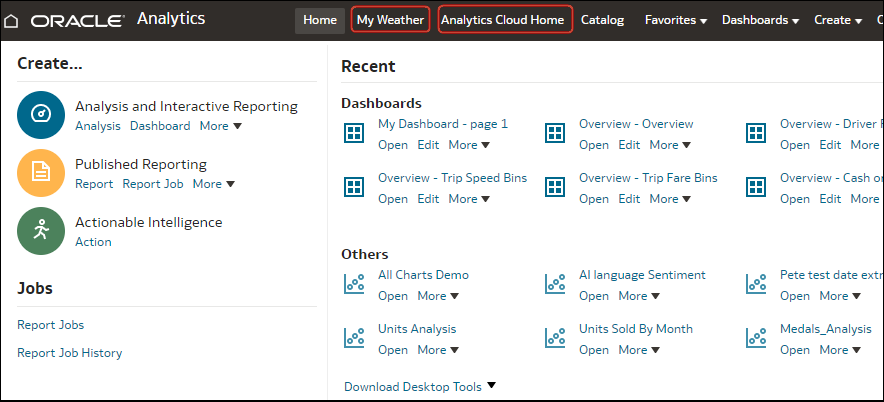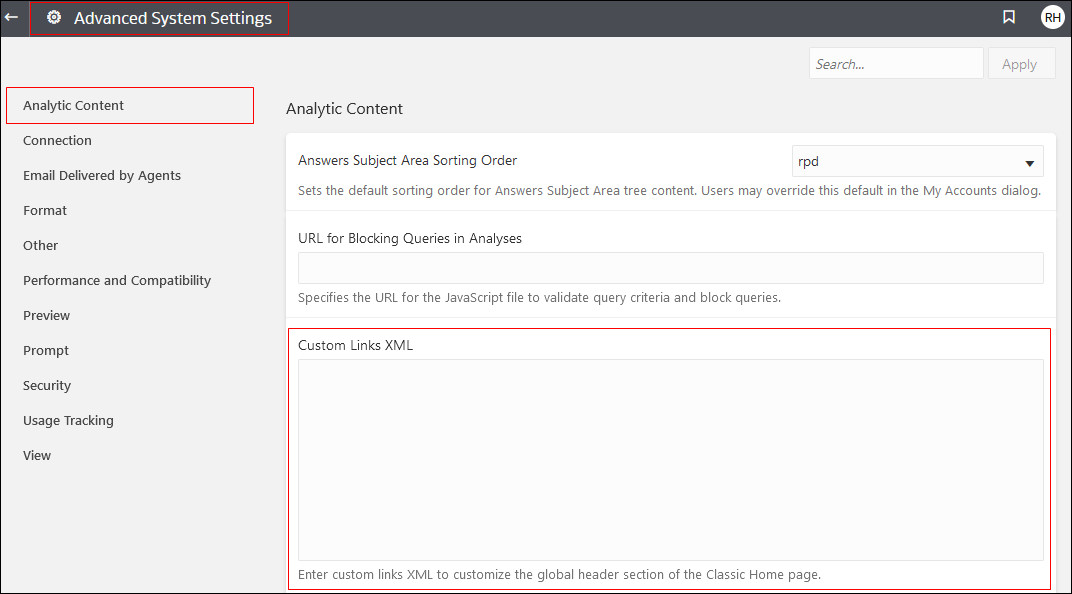Customize Links on the Classic Home Page
You can configure the Classic Home page to display custom links. For example, you might add a link to a website showing the local weather, or a link to the Oracle Analytics home page to enable business analysts to navigate from the Classic Home page to workbooks and visualizations.
In this example, links are added for "My Weather" and "Analytics Cloud Home".
Description of the illustration customlinksclassic.png
To add custom links, add XML code to the Custom Links XML system setting. To access system settings, go to the Oracle Analytics home page, click Navigator ![]() , then Console, then Advanced System Settings, then Analytic Content).
, then Console, then Advanced System Settings, then Analytic Content). 
Description of the illustration custom-links.jpg
You can use XML code to specify links and attributes, including the following:
-
The text for the link (either a static string or a message name to use for localization).
-
A target URL.
-
Whether the target link opens in the current page or opens in a new tab or window.
-
The relative ordering of links in the header.
-
An optional icon to use with the link.
This example displays two custom links to the left of the Catalog link in the global header of the Classic Home page.
<?xml version="1.0" encoding="utf-8"?>
<customLinks xmlns="com.siebel.analytics.web/customlinks/v1">
<link id="1" name="My Weather" description="Local weather site" src="https://www.example.com/weather" target="blank" >
<locations>
<location name="header" insertBefore="catalog"/>
</locations>
</link>
<link id="1" name="Analytics Cloud Home" description="OAC Viz Home Page" src="https://<OAC example URL>.analytics.ocp.oraclecloud.com/ui/dv/?pageid=home" target="blank" >
<locations>
<location name="header" insertBefore="catalog"/>
</locations>
</link>
</customLinks>Note:
To obtain the link for Oracle Analytics home page, log into Oracle Analytics, copy the URL, and paste it into thesrc="<target link>" element (as shown in the
example XML code).
This table describes the elements and attributes that you can specify for custom links.
| Element or Attribute | Optional? | Data Type | Description |
|---|---|---|---|
|
|
Optional |
Boolean |
Specifies that in accessibility mode, the link is available only when the accessibility attribute is set to true. Values are true and false, and false is the default. In previous updates, the |
|
|
Optional |
String |
Specifies the description of the link (not translated). |
|
|
Optional |
String |
Specifies the file name of an icon to display with the link in the global header. The display of icons is controlled by the fmap syntax. |
|
|
Required |
String |
Use as a unique ID that specifies the position of the link. You can include IDs for custom links to position them relative to default links. |
|
|
Required |
String |
Specifies the name of the link that isn't translated. |
|
|
Optional |
String |
Specifies the name of privileges that a user must be granted to see the link. The privileges are indicated as an expression, as shown in the following example:
|
|
|
Required |
String |
Specifies the URL for the link. |
|
|
Optional |
String |
Specifies the browser window in which to open the link. The values are: self: Opens in same window in which Oracle Analytics is running. blank: Opens in a new window. any-name: Opens in a window with the specified name. |
|
|
Optional |
String |
Specifies the ID of an existing link to the left of which you want to add the custom link. For example, to add a custom link to the left of the Catalog link, specifiy Valid IDs:
If you make a mistake and specify an invalid ID, the link is inserted in a default location. |
|
|
Required |
String |
Use this attribute if you include the locations parent element. The values are: header: Specifies to include the link in the global header. |
|
|
Optional |
Not Applicable |
Use as the parent element for specifying the locations of the links to add. If you don’t specify a location, then by default links are included before the Help link in the global header and at the end of the Get Started section. |